

Original Article - Year 2006 - Volume 21 -
Ascending upper blepharoplasty or upper eyelid lifting
Blefaroplastia Superior Ascendente ou Lifting Palpebral Superior
ABSTRACT
The author presents his experience with a personal technique used, in the initial cases, for correction of sub-eyebrow skin ptosis over the upper eyelid, a frequent occurrence after an upper blepharoplasty performed without a concomitant temporal and frontal lifting. Initially, the author makes a brief historical report about the incisions in blepharoplasty. The access way for this procedure is a sub-eyebrow zigzag incision that can be used for frontal and glabelar procedures and also for primary blepharoplasties in some patients. It is a zigzag or W sub-eyebrow incision, below and between the inferior eyebrow hairs, followed by a subcutaneous undermining and orbicularis muscle incisions to treat the fat pads and Roof excesses, to ascend the eyelid's lateral corner and to perform a resection of the skin excess, making a true upper eyelid lifting. In the studied period along the past 6 years, 42 patients were submitted to this technique and the author extended the indications, listed in a selection of patients. High satisfaction levels with the initial results and few complications were observed. All the patients had important aesthetic improvement. The author concludes that this new method is a simple and safe solution for correction of bad results in eyelid surgery and a new alternative to upper blepharoplasty.
Keywords: Eyelids, surgery. Blepharoplasty. Surgery, plastic
RESUMO
O autor relata sua experiência com uma técnica pessoal que, inicialmente, foi utilizada para correção de ptose da pele da reborda orbitária (pele subsuperciliar) sobre a pálpebra, a qual é resultado insatisfatório de blefaroplastia superior, executada isoladamente em pacientes com indicação de ritidoplastia frontotemporal. Inicialmente, o autor faz algumas considerações históricas sobre os acessos utilizados na blefaroplastia. A via de acesso da técnica também facilita o acesso às regiões frontal e glabelar e pode, em certos pacientes, ser utilizada para blefaroplastia primária. É uma incisão em ziguezague ou W, junto aos pêlos inferiores do supercílio, seguida de descolamento supra-orbicular e, por este campo, são realizados os demais tempos para o tratamento de bolsas, excessos de gordura retro-orbicular (Roof), levantamento do canto lateral e ressecção do excesso cutâneo, fazendo um verdadeiro lifting da pálpebra superior. Ao longo dos últimos 6 anos, foram operados 42 pacientes por esta técnica e, durante o período estudado, o autor ampliou as indicações. Estas estão relacionadas na seleção dos pacientes para o método utilizado. Os resultados iniciais foram altamente satisfatórios, com baixo índice de complicações e, no acompanhamento tardio, todos os pacientes obtiveram melhora estética importante. O autor conclui que esta nova abordagem representou uma solução simples e segura para correção de maus resultados em cirurgia palpebral e uma nova alternativa para a blefaroplastia superior.
Palavras-chave: Pálpebras, cirurgia. Blefaroplastia. Cirurgia plástica
Os primeiros relatos sobre as pregas cutâneas palpebrais foram feitos por Beer, em 1792, e o termo "blefaroplastia" foi usado pela primeira vez por Von Graefe, em 1818, segundo relato de Rees1, que também cita a importância de Sichel, Bourguet, Claoué e Passot na cirurgia palpebral. Sichel, em 1844, traz à luz uma das primeiras descrições da gordura orbitária herniada. Ao final do século XIX, ainda era defendida a remoção de pele e gordura apenas quando os excessos fossem absurdamente exagerados. A cirurgia cosmética das pálpebras veio a ser executada muito mais tarde, já no século XX, e algumas das incisões descritas nos primeiros 30 anos do século foram mais conjecturas do que realidade, sendo que muitas operações eram mantidas em segredo. Bourguet, em 1929, foi o primeiro a advogar a remoção de gordura na cirurgia palpebral e identificou dois diferentes compartimentos adiposos nas pálpebras superiores. O acesso transconjuntival foi proposto por Claoué, em 1931, e por Passot, no mesmo ano. Apenas em 1951, Castañares2 publica uma completa descrição dos compartimentos gordurosos.
As incisões para a realização da blefaroplastia sofreram variações técnicas em relação ao desenho, mas prevaleceu o conceito de que a cicatriz final deve cair naturalmente na prega supratarsal, porque ali, na área conhecida como sulco palpebral, ela fica bem dissimulada.
Encontramos uma interessante alternativa para melhor resultado da blefaroplastia superior, em certos casos, apresentada como Nota Prévia, no 42º Congresso Brasileiro de Cirurgia Plástica, em 2005 3.
MÉTODO
Neste estudo, foram acompanhados 42 pacientes, 37 do sexo feminino e 5 do masculino, com idade variando entre 28 e 66 anos, entre junho de 2000 e outubro de 2005. Todos os pacientes consentiram em submeter-se a uma técnica cirúrgica original que o autor empregou, inicialmente, em pacientes que se queixavam de insuficiente correção de excesso cutâneo nas pálpebras superiores. Tais pacientes haviam sido operados sem concomitância com ritidoplastia da área fronto-temporal e não aceitavam a realização dessa cirurgia. Ao longo do período estudado, o autor encontrou outras indicações para o procedimento. Foram sendo selecionados, portanto, pacientes que necessitavam de:
1. Correção de ptose da pele orbitária (ou subsuperciliar) secundária a blefaroplastia;
2. Blefaroplastia superior primária em pacientes que tenham sobrancelhas naturalmente altas ou artificialmente elevadas por micropigmentação ou por excesso de depilação dos supercílios e apresentam, também, a mesma ptose sobre as pálpebras. Nestes pacientes, a suspensão da região frontotemporal pode deixar as sobrancelhas pigmentadas excessivamente altas;
3. Correção do "olho gordo" por excesso da gordura retroorbicular superior (Roof), existente, com freqüência, sobre a borda e o septo orbitários e situada lateralmente aos dois clássicos compartimentos descritos por Castañares atrás da estrutura septal. Desde 1980, esta gordura retro-orbicular já tem sido ressecada4 junto com uma faixa do músculo orbicular, e sua ressecção tem sido descrita por diversos autores5-7. Recentemente, um estudo anatômico dos compartimentos adiposos da pálpebra superior indica sua ressecção para melhor resultado estético8;
4. Suspensão do canto palpebral lateral nos casos em que tenham ocorrido as indicações anteriores, associada ou não à cantopexia;
5. Blefaroplastia primária ou secundária, quando não seja desejada a ascensão dos supercílios durante a ritidoplastia;
6. Blefaroplastia primária em presença de cicatrizes ou lesões cutâneas acima do sulco palpebral e junto aos supercílios;
7. Facilitar o acesso à glabela para ressecção dos músculos corrugadores em relação ao conseguido pela incisão do sulco palpebral9 e para a elevação dos supercílios do que o conseguido pela transblefaroplastia10.
Técnica Cirúrgica
É um procedimento realizado por incisão em ziguezague, margeando inferiormente os supercílios e biselada acentuadamente para preservação dos folículos pilosos até encontrar o músculo orbicular (Figuras 1A e 1B). A incisão inicia-se um pouco antes da extremidade medial das sobrancelhas, segue escondendo as pontas superiores do ziguezague entre os pêlos superciliares e, se necessário, ultrapassa 1 cm ou mais após a extremidade lateral do supercílio. É importante, se a paciente assim o desejar, que ela depile pêlos superciliares inferiores antes da cirurgia para que a incisão seja mais bem situada.
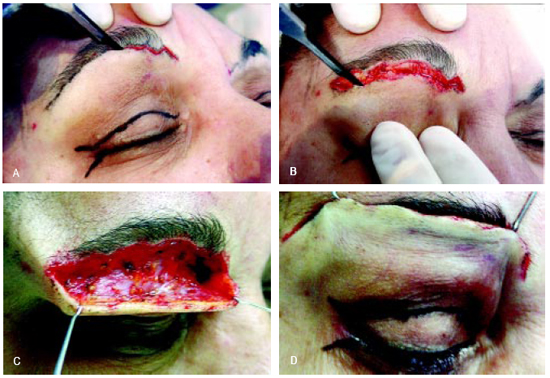
Figura 1 - A e B: Incisão em ziguezague, com as pontas superiores entre os pêlos superciliares, em bisel frontal acentuado para preservação folicular. C: Área de descolamento supra-orbicular limitado ao total da ressecção calculada pela tração mostrada em D.
A seguir, faz-se descolamento supra-orbicular limitado, aproximadamente, ao que previamente fora calculado como a necessária retirada de pele (Figuras 1C e 1D). Se necessário, pode ser feita, facilmente, abordagem para exérese de bolsas orbitárias (Figuras 2A e 2B), como também acesso glabelar aos músculos corrugadores.
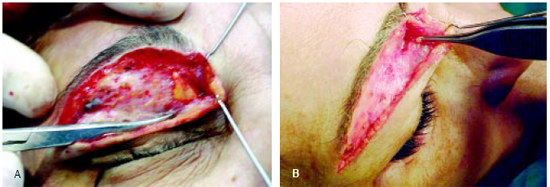
Figura 2 - Acesso às bolsas orbitárias interna e média. A: tratamento de bolsas após ressecção do Roof. No canto externo, vê-se a sutura do músculo. B: Acesso às bolsas antes da exérese da gordura retro-orbicular.
Posteriormente, incisa-se 1,5 a 2 cm do músculo orbicular a partir do canto lateral, inferiormente à borda orbitária, propiciando acesso para o excesso de Roof (Figura 3A). Com tesoura de ponta romba, separa-se esta gordura da face retro-orbicular (Figura 3B) e faz-se sua exérese sobre a reborda e septo orbitários (Figuras 3C, 3D, 3E e 3F), cuidadosamente, procurando identificar vasos e evitando ultrapassar a reborda para a preservação de ramos nervosos. Nesta área, realiza-se minuciosa hemostasia por eletrocoagulação, devido ao rico plexo vascular.
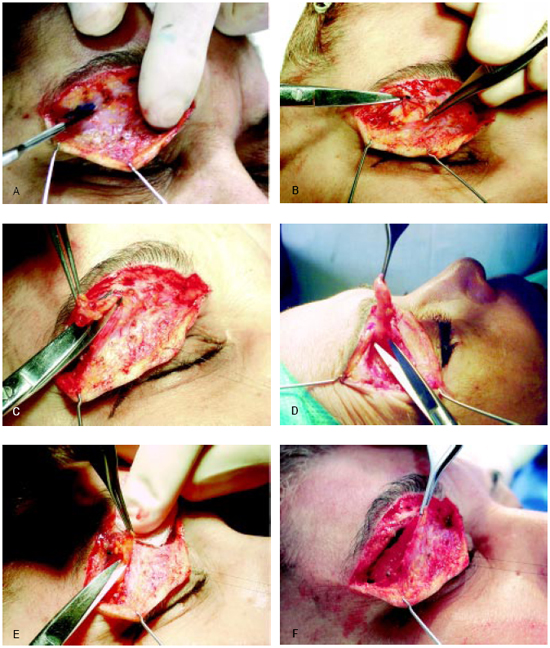
Figura 3 - A: Incisão muscular abaixo da reborda orbitária. B: Descolamento retro-orbicular. C e D: Exérese de excesso lateral do Roof. E: Completando a exérese mais medialmente. F: Ressecado o excesso de gordura vê-se a reborda e septo orbitários ao fundo.
As bordas do orbicular são, então, suturadas. Se for desejada ascensão do canto lateral, pode-se ressecar um segmento calculado para a ascensão desejada, de músculo orbicular (Figura 4A), e ancorar a borda inferior do músculo, com um ou dois pontos, ao periósteo da reborda orbitária (Figuras 4B e 4C) e, em seguida, suturar o músculo orbicular. A Figura 4D mostra a elevação do canto palpebral externo.
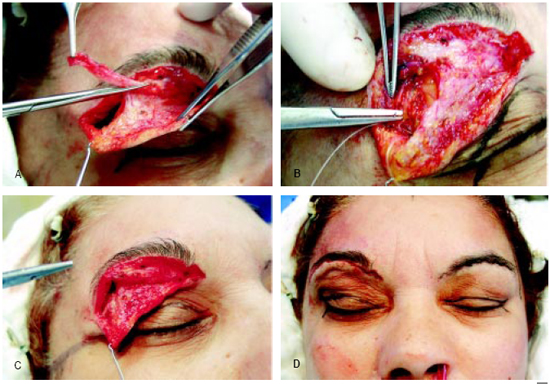
Figura 4 - A: Ressecção de cunha lateral de músculo orbicular. B: Passando fio de nylon incolor 5-0, no periósteo da reborda orbitária e na borda inferior do músculo orbicular. C: Fechando segundo ponto de fixação ao periósteo. D: Na comparação, observa-se ascensão do canto lateral da pálpebra superior direita. Observar a diferença sofrida na marcação do sulco palpebral direito em relação ao lado esquerdo.
O excesso de pele é ressecado sob tração da pele descolada para cima, evitando deixar as pálpebras abertas por ressecção excessiva, mas é prudente entreabrí-las um pouco, para compensar a suave elevação das sobrancelhas que ocorre com a tração da pele, para evitar hipocorreção. A ressecção acompanha o formato em ziguezague da incisão original (Figuras 5A e 5B).
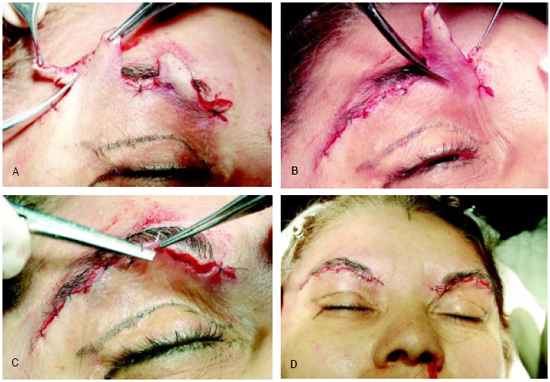
Figura 5 - A e B: Ressecção do excesso cutâneo, acompanhada com pontos simples nas pontas do ziguezague. Iniciar ressecção pelos cantos para não deixar "orelhas". C e D: continuação da sutura e visão dos dois lados operados.
Pontos simples de nylon 6-0 aproximam as pontas do retalho aos seus respectivos pontos de encaixe e uma sutura contínua completa o fechamento (Figuras 5C e 5D). O curativo é feito apenas com fita cirúrgica. Após a retirada da sutura, é recomendável o uso de fitas, continuamente, por mais 7 dias e, se possível, ao menos durante a noite até o 30o dia.
RESULTADOS
O grau de satisfação foi elevado sob o ponto de vista dos pacientes. Sempre resultaram cicatrizes dificilmente perceptíveis. O grau maior de satisfação foi alcançado nos casos em que foi feito o ancoramento ao periósteo e ressecada a quantidade correta de pele e músculo orbicular. Não ocorreram maus resultados. Entretanto, em nossa avaliação, consideramos 7 (16,67%) resultados insuficientes. Em 5 destes pacientes, ocorreu menor grau de correção por insuficiente ressecção e falta de ancoramento, e, em 2, a cicatriz da blefaroplastia primária, que não era de boa qualidade, ficou visível após a cirurgia. Deve-se examinar, portanto, cuidadosamente, a qualidade da cicatriz anterior, pois a ascensão desta cicatriz, acima do sulco órbito-palpebral, poderá ser motivo de queixas.
Em duas pacientes com supercílios artificiais por micropigmentação e em outra em que estes eram finos e com pêlos esparsos, e havia a intenção de micropigmentar, foram feitas incisões lineares também com bons resultados, mas não as recomendamos para pacientes com supercílios normais. A micropigmentação constitui-se em bom método auxiliar para aumentar espessura ou imitar supercílios e consegue disfarçar cicatrizes em casos de pacientes com poucos pêlos nas sobrancelhas (Figura 7).
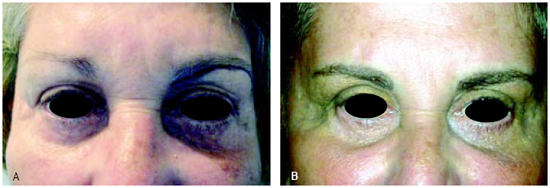
Figura 7 - A: Paciente de 66 anos, duas blefaroplastias anteriores, queixa de excesso sobre os sulcos palpebrais. B: Cirurgia realizada com incisão linear, pois a paciente desejava pigmentação das sobrancelhas, que realizada posteriormente disfarçou as cicatrizes. Resultado de 1 ano de pós-operatório.
O desengorduramento retro-orbicular, em todos os casos em que foi feito, proporcionou excelentes resultados estéticos.
Não ocorreu rebaixamento dos supercílios. Com freqüência observou-se pele mais escurecida, temporariamente, logo abaixo dos supercílios. Isto se deve ao fato de que a pele ressecada é mais clara do que a pele situada acima do sulco palpebral que ascende para ser suturada ao supercílio. Dentro dos primeiros 6 meses, esse efeito desaparece. Resultados imediatos e tardios podem ser observados nas Figuras 6 a 10.
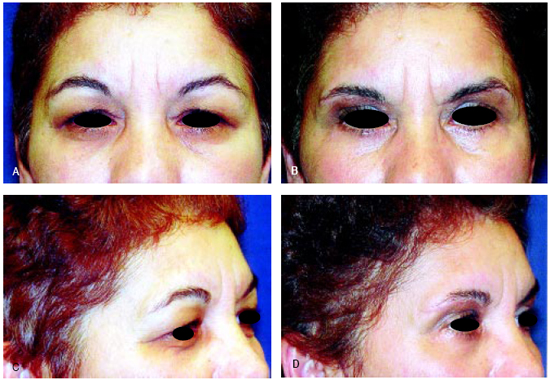
Figura 6 - Resultado 3 meses pós-cirurgia descrita nas Figuras 1 a 5. A e C: Aspecto pré-operatório de frente e oblíqua direita. B e D: Aspecto pós-operatório de frente e oblíqua direita.
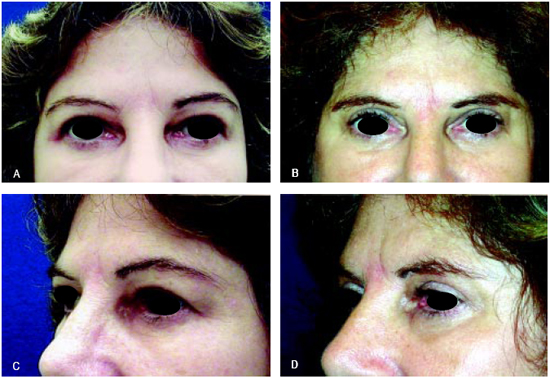
Figura 8 - A e C: Paciente de 48 anos, queixa de "olho gordo" e excesso palpebral secundário à blefaroplastia. B e D: Resultado visto de frente e oblíqua esquerda após 2 anos.
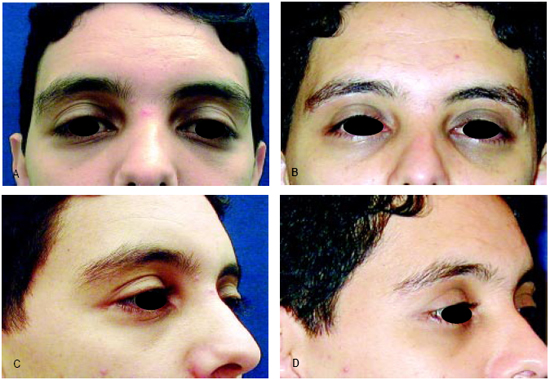
Figura 9 - A e C: Paciente com 28 anos, queixa de insatisfação com o formato e espessura das pálpebras superiores. B e D: Resultado obtido após 1 ano com a blefaroplastia ascendente. Realizada ressecção de orbicular lateral com ancoramento ao periósteo e sem exérese de Roof.

Figura 10 - Paciente de 32 anos queixando-se de insatisfação indefinida com suas pálpebras superiores. A e B: Aspectos pré-operatórios de frente e oblíqua esquerda.
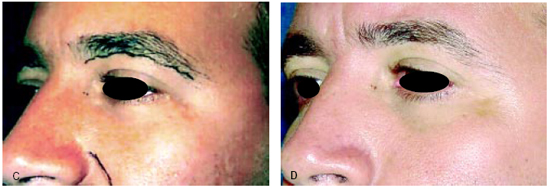
Figura 10 - C e D: Resultado obtido 5 anos após a cirurgia com exérese de Roof e mínima ressecção cutânea. O detalhe da Figura D mostra a difícil percepção da cicatriz e a naturalidade das sobrancelhas.
Como complicações, tivemos dois casos de hematoma em uma das pálpebras, no espaço criado pela ressecção do Roof, devido a insuficiente hemostasia.
COMENTÁRIOS
Um falso excesso palpebral causado pela ptose superciliar, em pacientes que não desejem a ascensão dos supercílios, se for retirado pelo acesso clássico poderá impossibilitar o natural fechamento palpebral passivo durante o sono e é causa de graves comprometimentos oculares. A presente técnica foi desenvolvida visando à solução desse problema, que freqüentemente leva à consulta pacientes insatisfeitos com uma blefaroplastia realizada. O falso excesso é notado, também, com supercílios artificialmente elevados por depilação ou por micropigmentação. O resultado da blefaroplastia deixa a desejar, principalmente, em pacientes do sexo feminino, mais exigentes com a perfeição do resultado, pois este falso excesso impossibilita, também, um bom resultado com a maquiagem. Os resultados obtidos nos primeiros casos estimularam a ampliação das indicações.
É evidente que a técnica deve ser contra-indicada em pacientes queloideanos, ou que apresentem alguma possibilidade ou expressem receio de má cicatrização, e naqueles em que a elevação das sobrancelhas seja absolutamente necessária para um melhor resultado. Pode ser executada, em casos especiais como os de sobrancelhas artificiais por micropigmentação, por uma incisão linear, embora o resultado cicatricial ideal foi atingido com a incisão em ziguezague.
Concluímos pela segurança e utilidade da abordagem das pálpebras superiores por esta via subsuperciliar para a correção seletiva dos casos que apresentaram as indicações citadas, preferindo a incisão em linha quebrada, ou em ziguezague ou múltiplo W, que proporciona cicatrizes pouco perceptíveis inclusive em homens, e sem a necessidade de disfarce por maquiagem.
AGRADECIMENTOS
O autor agradece a revisão do texto ao Prof. Ronaldo Pontes e a pesquisa bibliográfica sobre a originalidade da técnica e o estímulo a esta publicação ao Prof. Ramil Sinder.
REFERÊNCIAS BIBLIOGRÁFICAS
1. Rees TD. Blepharoplasty. In: Rees TD, Wood-Smith D, eds. Cosmetic facial surgery. Philadelphia: Saunders; 1973. p.44-133.
2. Castañares S. Blepharoplasty for herniated intra-orbital fat. Anatomical basis for a new approach. Plast Reconstr Surg. 1951;8:46.
3. Pimentel LAS. Blefaroplastia superior ascendente or upper eyelid lifting. In: 42º Congresso Brasileiro de Cirurgia Plástica;2005 Nov 13; Belo Horizonte, BH.
5. Owsley Jr JQ. Resection of the prominent lateral fat pad during upper lid blepharoplasty. Plast Reconstr Surg. 1980;65(1):4-9.
6. May Jr JW, Fearon J, Zingarelli P. Retro-orbicularis oculus fat (ROOF) resection in aesthetic blepharoplasty: a 6 year study in 63 patients. Plast Reconstr Surg. 1990;86(4):682-9.
7. Aiache AE, Ramirez OH. The suborbicularis oculi fat pads: an anatomic and clinical study. Plast Reconstr Surg. 1995;95(1):37-42.
8. Mouly R, Auclair E, Staub S. Lateral fat in upper blepharoplasty. Ann Chir Plast Esthet. 1995;40(1):53-7.
9. Persichetti P, Di Lella F, Delfino S, Scuderi N. Adipose compartments of the upper eyelid: anatomy applied to blepharoplasty. Plast Reconstr Surg. 2004;113(1):373-80.
10. Guyuron B, Michelow BJ, Thomas T. Corrugator supercilii muscle resection through blepharoplasty incision. Plast Reconstr Surg. 1995;95(4):691-6.
Membro Titular da Sociedade Brasileira de Cirurgia Plástica e Membro do Staff do Serviço Credenciado da Clínica Fluminense de Cirurgia Plástica.
Correspondência para:
Luiz A. S. Pimentel
Rua Nilo Peçanha 59, Ingá
Niterói, RJ - Brasil - CEP: 24210-480
Tel. 0xx21 2717-9966
E-mail: cirurgiaplastica@luizpimentel.com.br
Trabalho realizado na Clínica Fluminense de Cirurgia Plástica - Niterói, RJ. Apresentado no 42º Congresso Brasileiro de Cirurgia Plástica, em 13 de novembro de 2005.
Artigo recebido: 11/01/2006
Artigo aprovado: 23/03/2006


 Read in Portuguese
Read in Portuguese
 Read in English
Read in English
 PDF PT
PDF PT
 Print
Print
 Send this article by email
Send this article by email
 How to Cite
How to Cite
 Mendeley
Mendeley
 Pocket
Pocket
 Twitter
Twitter